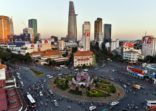“The correlation between domestic growth in different frontier market countries is very low because the economies are being driven by domestic political and economic factors rather than by global factors,” the London-based manager told FSA.
The MSCI Frontier Markets Index has a low correlation (0.3-0.4) to emerging or developed markets indices, as these frontier nations are driven by domestic economic growth and political reforms, rather than what happens in China or the US. Frontier markets also have a lower ratio of US dollar debt than the EM countries, he added.
In terms of valuations, frontier markets tend to be lower at 10.9x the one-year forward price-earnings ratio compared to EM’s 16x and DM’s 20x, he added.
The index includes 30 countries, including five in Asia − Bangladesh, Kazakhstan, Pakistan, Sri Lanka and Vietnam − as well as Argentina, six countries in Eastern Europe and 18 markets in Africa and the Middle East.
Frontier markets vs Emerging markets
|
|
Three-year annualised return |
Three-year annualised volatility |
|
Magna New Frontiers Fund |
9.27% |
13.37 |
|
MSCI Frontier Markets Index |
-2.66% |
11.63 |
|
MSCI Argentina Index |
16.86% |
38.85 |
|
MSCI Pakistan Index |
7% |
19.32 |
|
MSCI Emerging Markets Index |
2.16% |
16.15 |
Source: FE, performance measured in US dollars
Individually, however, frontier markets can be very volatile. The Charlemagne fund, available for sale in Singapore, is therefore benchmark agnostic and flexible among country allocations, he said.
The fund focuses on under-owned and under-researched stocks that can benefit from domestic growth that is driven by economic or political reforms. Most stocks have a market capitalisation of $1bn-$10bn.
“Two years ago, we had zero holdings in Pakistan or Argentina. Now, because of the reform processes, we have 35% of the portfolio in these two countries”, which are also among biggest country weightings in the portfolio. Argentina was previously not open to foreign investors due to currency controls, while Pakistan was governed by the military, he explained.
As a result, the two countries have had little company research for the last decade as well as a very cheap stock market.
While he expects Pakistan and Argentina to be upgraded to emerging markets by the MSCI in June 2018, he said there are more frontier investing opportunities, such as the opening up of Zimbabwe, Myanmar and Ethiopia.
“There are 170 countries in the world that are not [classified as] developed or emerging markets, which are potentially frontier. Now we have investments in about 14 of them.”
Turnover for the fund is about 1.4x per year, he noted, while 72% of the holdings are not in the benchmark MSCI Frontier Markets Index.
“A lot of the big stocks in the benchmark are companies like state-owned oil companies, which we don’t think are the best investments. There are also some countries that are not in the frontier index, like Georgia, where we see a lot of opportunities.”
Reform-linked sectors
The manager is underweight sectors such as metals and mining or oil and gas, which are easily affected by external demand and supply. More emphasis is on industrials such as cement and utilities, he said.
Bokor-Ingram particularly likes the healthcare, education and utilities sectors, which are typically among the first beneficiaries of the reform process. “When the population becomes a little bit wealthier, the first two things the government spends money on is healthcare and education.”
The key driver for frontier markets is whether the government has the political power to push through reforms quickly, he said. One crucial indicator is the effectiveness of measures used to fight corruption.
He monitors whether corruption is reducing. Improvement in that area signals that the government is actually committed to reform and not just delivering rhetoric.
Even though the macro reform indicators are important, Bokor-Ingram said he uses a bottom-up approach for portfolio construction. As an example, he cited Egypt, which is going through a strong reform process, attracting the attention of investors.
“But it has a very small weighting in the portfolio because we can’t find the right company at the right valuation.”
Three-year performance of the Magna New Frontiers Fund, its benchmark, and the category average of emerging market equity funds available for sale in Singapore, according to FE.

















